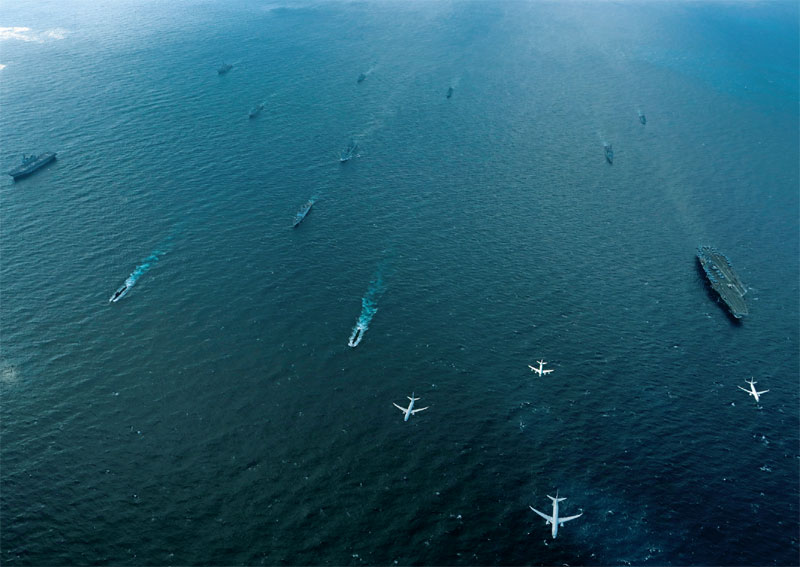IAF And IN bolstering jointmanship to attain new heights
 Prof D.K. Pandey
Prof D.K. Pandey
The Indian Ocean is significant in India’s maritime interests and concerns. India’s strategic position grants it a favourable position within the Indian Ocean Region (IOR), while its vast size, trade connections and exclusive economic zone (EEZ) establish a clear correlation between its security environment and the surrounding extended vicinity.
Given geopolitics in IOR, the Indian Navy (IN) ensures the maintenance of the highest levels of operational preparedness for potential conflicts, considering all relevant circumstances. Factors that need to be considered are the tempo and severity of contemporary warfare, the present security environment and the potential for an adversary to launch unexpected assaults on India. In such scenarios, promptly responding to unforeseen events could be paramount. Enhancing our intelligence capabilities and continuously monitoring and analysing the intentions of potential adversaries will contribute to the promotion of preparedness.
The advantageous geographical position of the Indian peninsula, extending into the Indian Ocean and adjacent to the Andaman Nicobar Islands, grants India a significant geostrategic edge over China. This advantage stems from India’s proximity to vital shipping routes and strategic bottlenecks. Thus far, India has effectively utilised its geographical advantage to preserve a favourable balance of power in relation to China. Over the past decade, China has significantly advanced its maritime capabilities. China believes in an expansionist approach. This has coincided with the expansion of the country’s economic and political dominance in the IOR. The Chinese interest in IOR is of utmost importance to China due to its heavy reliance on maritime transportation for global trade and energy requirements.
The Indian Navy is a highly proficient and integrated force that possesses the ability to operate effectively in three dimensions: above, on, and below the surface of the oceans. The IN’s multifaceted capabilities and constant presence in the Indian Ocean have attained it a position of maritime leadership. These measures align with the Prime Minister’s goal of achieving ‘Security and Growth for All in the Region’ (SAGAR). India’s maritime neighbours face various security threats, including escalating instabilities, developing geopolitical and ethnic fault lines, expanding military capabilities and evolving alliances.
Armed forces worldwide are increasingly recognising the significance of jointmanship. Consequently, considerable attempts have been expended recently to foster collaboration and facilitate the integration of India’s three armed forces. The three military branches, Indian Army(IA), IN and Indian Air Force (IAF), share the combined responsibility for the ground and air defence of the Andaman and Nicobar Islands. The headquarters, Andaman and Nicobar Command, in Port Blair, effectively coordinates it. The tri-services command represents the sole entity of its kind, overseen by a commander-in-chief who is appointed rotationally from the three Services. The naval officer-in-charge, Lakshadweep, leads the local naval defence operations of the Lakshadweep group of islands.
Joint Operations
The IN and IAF have a longstanding tradition of collaborative operations, particularly during times of hostilities and during peacetime training exercises.
(a) Indo-Pakistani War, 1971: The IN executed a courageous attack on Karachi, the commercial hub centre and major port city of Pakistan. The IAF was pivotal in executing Operation Trident and Operation Python, two significant naval operations during the war of 1971. The IAF made substantial contributions during the naval operations, crippling Pakistan’s naval capabilities. These operations encompassed providing air cover for the Indian Navy’s missile boats, executing diversionary air raids by Sukhoi Su-7 on Pakistani targets, and launching an offensive against the Masroor.
IAF fighters, notably the MiG-21 and Hawker Hunter, patrolled Karachi’s skies, acting as a deterrent against potential Pakistani counterattacks. The primary Pakistani Air Force base, Masroor, was tasked to provide necessary air support to the Pakistan Navy operating in the Karachi area. The attacks crippled the Pakistani Navy, gave India control of the sea lanes in the western Indian Ocean, and boosted morale. These actions demonstrated the IAF’s developing capabilities and strategic significance in addition to being a significant factor in India’s victory in the Indo-Pakistani War of 1971.
(b) Kargil Conflict, 1999: We commemorate the anniversary of India’s spectacular victory in the Kargil War on July 26. The military confrontation occurred in the frigid altitudes of Kargil, situated in the region of Kashmir, spanning from May to July 1999. Three separate but coordinated military actions occurred during this conflict: the Army’s Operation Vijay, the Air Force’s Operation Safed Sagar, and the Navy’s Operation Talwar. However, coordination between the IAF and IN was limited during this conflict due to its nature being more land-based. Nonetheless, for Operation Talwar, every component of the naval force, including IAF maritime resources, was mobilised.
Initially, the locations of Pakistan Navy assets were determined. Secondly, measures were taken to safeguard the navy’s high-value assets at sea, including Bombay High, and the coastal regions. The operation in the Arabian Sea witnessed the most extensive deployment of combatant vessels ever. The indication became evident as India progressively deployed its naval aviation, submarine, amphibious and Coast Guard capabilities in high-speed operations, which encompassed Electronic Warfare exercises. During this extensive deployment in the Northern Arabian Sea, the Pakistani media reported that approximately thirty ships were approaching Karachi. The operation was appreciated by military analysts.
(c) Peacetime Exercises: Conducting joint exercises to enhance interoperability, coordination and readiness for joint operations is essential for productive operations in war situations. The TROPEX (Theatre-level Readiness Operational Exercise), a significant multi-domain exercise spanning one month, including the Army, Navy, IAF, Coast Guard and special forces in the strategically positioned archipelago, is conducted biennially. The high-voltage exercise tests mobilisation, operations and combat preparedness to evaluate and execute various plans and emergencies in a realistic tactical scenario. The IN can refine force architecture, combat deployments, operational logistics and training and material requirements with the help of precise insights provided by the TROPEX.

You must be logged in to view this content.

